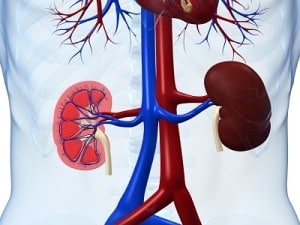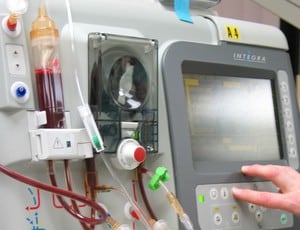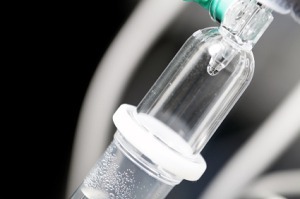Incidence of CRBSI in patients undergoing cytoreductive surgery

The aim of this study was to calculate the incidence of catheter-related infection (CRI) in a CRS and HIPEC patient population and to assess its influence on length of hospital stay” Waters et al (2019). Abstract: Background: Cytoreductive surgery (CRS) and hyperthermic intra-peritoneal chemotherapy (HIPEC) is a complex surgical intervention with associated risks. Central venous […]
Administration of Vancomycin at high doses in patients with post neurosurgical meningitis

The aim of this study was to evaluate and compare CSF concentration and serum pharmacokinetics of high dose vancomycin by continuous infusion vs. intermittent infusion in post neurosurgical meningitis patients” Taheri et al 92018). Abstract: Poor penetration of vancomycin into Central Nervous System (CNS) can lead to treatment failure. The aim of this study was […]
Vascular access choice in children on maintenance hemodialysis

Arteriovenous fistulas (AVFs) have been recommended as the preferred vascular access for pediatric patients on maintenance hemodialysis (HD), but data comparing AVFs with other access types are scant. We studied vascular access choice, placement, complications, and outcomes in children” Borzych-Duzalka et al (2019). Abstract: RATIONALE & OBJECTIVE: Arteriovenous fistulas (AVFs) have been recommended as the […]
Systematic evaluation of pharmacometric models for vancomycin dosing

Vancomycin is a vital treatment option for patients suffering from critical infections, and therapeutic drug monitoring is recommended. Bayesian forecasting is reported to improve trough concentration monitoring for dose adjustment” Broeker et al (2019). Abstract: Objectives: Vancomycin is a vital treatment option for patients suffering from critical infections, and therapeutic drug monitoring is recommended. Bayesian […]
How to deliver central line care education at the point of care?

After a survey revealed practice gaps in central venous catheter care, one organization was challenged to identify a novel approach to educate nurses” Van Ryan et al (2019). Abstract: After a survey revealed practice gaps in central venous catheter care, one organization was challenged to identify a novel approach to educate nurses. Through a search […]
Systematic review of the effectiveness of bundles in preventing peripheral IV complications

The aim of this paper is to synthesize evidence on the effectiveness of PIVC insertion and maintenance bundles on preventing adverse events” Ray-Barruel et al (2019). Abstract: BACKGROUND: Evidence-based bundles have reduced central line bloodstream infection rates in adult intensive care units. To tackle peripheral intravenous catheter (PIVC) bloodstream infection, many hospitals have implemented PIVC […]
Bedside hand vein inspection for noninvasive central venous pressure assessment

Our purpose was to evaluate the feasibility and accuracy of CVP estimates assessed upon the height of hand veins collapse (HVC) using invasively measured CVP as the gold standard” Vogel et al (2019). Abstract: Rapid estimates of the central venous pressure (CVP) can be helpful to administer early fluid therapy or to manage cardiac preload […]
Use of continuous infusion ceftolozane–tazobactam with therapeutic drug monitoring

The safe and effective use of ceftolozane–tazobactam delivered via continuous infusion in a cystic fibrosis (CF) patient with reduced body weight and presumed augmented renal clearance is reported” Davis et al 92019). Abstract: Purpose: The safe and effective use of ceftolozane–tazobactam delivered via continuous infusion in a cystic fibrosis (CF) patient with reduced body weight […]
Reassessing standards of vascular access device care following audit

This article reports on the findings of a repeat audit of vascular access devices (VADs) in a district general hospital undertaken 4 years after a previous audit” McGuire et al 92019). Abstract: This article reports on the findings of a repeat audit of vascular access devices (VADs) in a district general hospital undertaken 4 years […]
Investigating the effect of local warming on vein diameter

This prospective non-randomised trial aimed to determine the effect of local warming on vein diameter in the antecubital area in adults aged 20–40 years” Homayouni et al 92019). Abstract: Background: Peripheral intravenous cannulation is the most prevalent invasive procedure performed on patients admitted to hospital. The procedure is not always easy to undertake and can […]
Intravenous fluid bolus rates and pediatric diabetic ketoacidosis resolution

Recent data have challenged the notion that rapid intravenous fluid administration results in adverse neurologic outcomes in children with diabetic ketoacidosis (DKA)” Pruitt et al (2019). Abstract: Background: Recent data have challenged the notion that rapid intravenous fluid administration results in adverse neurologic outcomes in children with diabetic ketoacidosis (DKA). While many physicians still administer […]
Lyme disease overdiagnosis in a large healthcare system

Lyme disease serological tests were overused in a large healthcare system, and positive results were frequently misinterpreted, leading to misdiagnosis and widespread antibiotic misuse” Webber et al (2019). Abstract: Objectives: To evaluate the impact of false-positive IgM immunoblots on Lyme disease treatment and case reporting in a large healthcare system. Methods: We obtained the results […]
Preventing vascular catheter infections ISID position paper

A panel of experts was convened by the International Society for Infectious Diseases (ISID) to overview recommendations on managing and preventing vascular catheter infections, specifically for the prevention and management of central line-associated bloodstream infections” Lutwick et al (2019). Abstract: A panel of experts was convened by the International Society for Infectious Diseases (ISID) to […]
Deviation from expected PICC securement care

A PICC line is a peripheral, through a vein inserted, central venous catheter. There are different engineered stabilisation devices – some are with and some without a sutural” Port and Bruchmann (2019). Abstract: A PICC line is a peripheral, through a vein inserted, central venous catheter. There are different engineered stabilisation devices – some are […]
Evaluation of educational content of YouTube videos focused on hand hygiene

In North America alone, 74% of adults use the Internet daily, and 80% of all users search for health-related information” Ortiz-Martínez et al (2019). Abstract: The recent rise of social media usage creates a platform for the dissemination of health information to large audiences. In North America alone, 74% of adults use the Internet daily, […]
Improved central line catheter care in a pediatric cardiac intensive care unit

This article illustrates how a multidisciplinary collaboration and the use of scientific evaluation and implementation tools can facilitate a decrease in CLABSIs” Thornton et al (2019). Abstract: Central line-associated bloodstream infection (CLABSI) can result in increased length of hospital stay and increased costs for both patients and organizations. This article illustrates how a multidisciplinary collaboration […]
Pancytopenia as a consequence of sepsis and intravenous antibiotic drug toxicity

This case presents a unique case of pancytopenia involving elements of drug-induced aplastic anemia as well as DIC-related sepsis” Cho et al (2019). Abstract: This case involves a 62-year-old male with a prior history of epidural abscess and L1-L2 osteodiscitis who was admitted because of low back pain. The patient was previously treated for methicillin-susceptible […]
What US hospitals are currently doing to prevent common device-associated infections?

Despite focused initiatives to reduce device-associated infection among hospitalised patients, the practices US hospitals are currently using are unknown. We thus used a national survey to ascertain the use of several established and novel practices to prevent device-associated infections” Saint et al 92019). Abstract: BACKGROUND: Despite focused initiatives to reduce device-associated infection among hospitalised patients, […]
Clinical impact of peripherally inserted central catheters vs implanted port catheters

Our aim was to study the incidence of catheter-related deep venous thrombosis in patients with cancer receiving chemotherapy through either a PICC or a PORT” Taxbro et al 92019). Abstract: BACKGROUND: Centrally inserted totally implanted vascular access ports (PORTs) and peripherally inserted central catheters (PICCs) are widely used for the administration of chemotherapy. Our aim […]
Interventions to improve hand hygiene compliance in emergency departments

To investigate hand hygiene compliance (HHC) rate, factors affecting the HHC rate, and intervention strategies to improve HHC in EDs” Sea et al (2019). Summary: Background: The emergency department (ED) is where hand hygiene problems are significant as the procedures in the ED are often high risk and invasive. To date, there have been no […]
Catheter-related bloodstream infection by Microbacterium paraoxydans in a pediatric patient

We herein reported an 11-year-old girl with acute leukemia who was found to have catheter-related bloodstream infection in her neutropenic phase. Gram-positive bacilli repeatedly grew on the blood cultures and were later confirmed by 16S rRNA analysis as Microbacterium paraoxydans” Amano et al (2019). Abstract: Microbacterium species are coryneform gram-positive rods that are widely distributed […]
Vascular access decision making in hemodialysis

Finally, CVC use is believed to result in excess mortality in patients on hemodialysis. However, recent data suggest that CVC use is simply a surrogate marker of sicker patients who are more likely to die, rather than being a mediator of mortality” Allon (2019) Abstract: This commentary critically examines key assumptions and recommendations in the […]
Peripheral IV catheter failure in 2019

Based on these data, we asked the lead author to update readers on the status of catheter failure and what has been improved since 2015″ Helm (2019). Abstract: Still considered a “hot topic” 4 years later, JIN is pleased to reprint this classic article from May/June 2015, Issue 3. Since publication, “Accepted but Unacceptable: Peripheral […]
Peripheral IV catheter failure from 2015

“Peripheral intravenous (IV) catheter insertion, the most common invasive hospital procedure performed worldwide, is associated with a variety of complications and an unacceptably high overall failure rate of 35% to 50% in even the best of hands” Helm et al (2019).
Flow properties of cannulae for extracorporeal membrane oxygenation

The use of extracorporeal life support devices such as extracorporeal membrane oxygenation in adults requires cannulation of the patient’s vessels with comparatively large diameter cannulae to allow circulation of large volumes of blood (>5 L/min)” Broman et al (2019). Abstract: The use of extracorporeal life support devices such as extracorporeal membrane oxygenation in adults requires cannulation […]
Genetics and functionality of vascular access devices in dialysis

Thromboses and stenoses of permanent vascular access appear to be a serious hazard for patients with end-stage kidney disease on programmed haemodialysis” Kalinin et al (2019). Abstract: Thromboses and stenoses of permanent vascular access appear to be a serious hazard for patients with end-stage kidney disease on programmed haemodialysis. Relapses of these pathological conditions are […]
Economic impact of antimicrobial stewardship programmes in hospitals

Antimicrobial stewardship programmes (ASPs) include strategies that enable sustainable management of rational anti-infective treatment in the clinical setting” Huebner et al (2019). Summary: Background: Antimicrobial stewardship programmes (ASPs) include strategies that enable sustainable management of rational anti-infective treatment in the clinical setting. The successful introduction of ASPs requires close interdisciplinary collaboration among various health professionals, […]
Patient diaries during use of central venous catheters

Limited data exist regarding patients’ experiences with outpatient CVADs. This study characterized outpatient CVAD care via 14-day patient diaries” Nailon et al (2019). Abstract: Patients are increasingly receiving therapy at home via central vascular access devices (CVADs). Limited data exist regarding patients’ experiences with outpatient CVADs. This study characterized outpatient CVAD care via 14-day patient […]
Effectiveness of the K-Card process for central venous catheter maintenance bundle

The purpose of this study was to evaluate the effectiveness of the K-Card process for central venous line (CVL) maintenance bundle compliance in a pediatric intensive care unit” Frith et al (2019). Abstract: BACKGROUND: The Kamishibai Card (K-Card) process is a storytelling methodology designed to help identify barriers and remove or redesign them. PURPOSE: The […]
Leaching of DEHP into solution during various infusion situations

The work explored the DEHP migration parameters in PVC infusion in clinic, based on the previous research on the test model of DEHP migrated from PVC infusion, to assess the safety of PVC infusion” Wang et al (2019). Abstract: The work explored the DEHP migration parameters in PVC infusion in clinic, based on the previous […]

